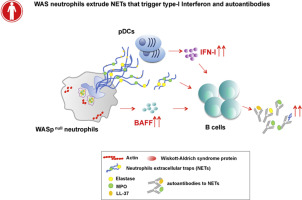Journal of Allergy and Clinical Immunology ( IF 11.4 ) Pub Date : 2018-02-13 , DOI: 10.1016/j.jaci.2017.11.063 Karla E Cervantes-Luevano 1 , Nicoletta Caronni 1 , Maria C Castiello 2 , Elena Fontana 3 , Giulia M Piperno 1 , Asma Naseem 1 , Paolo Uva 4 , Marita Bosticardo 5 , Genni E Marcovecchio 2 , Luigi D Notarangelo 6 , Maria P Cicalese 7 , Alessandro Aiuti 7 , Anna Villa 8 , Federica Benvenuti 1

|
Background
Wiskott-Aldrich syndrome (WAS) is a rare primary immunodeficiency caused by mutations in Wiskott-Aldrich syndrome protein (WASp), a key regulator of cytoskeletal dynamics in hematopoietic cells. A high proportion of patients experience autoimmunity caused by a breakdown in T- and B-cell tolerance. Moreover, excessive production of type I interferon (IFN-I) by plasmacytoid dendritic cells (pDCs) contributes to autoimmune signs; however, the factors that trigger excessive innate activation have not been defined.
Objective
Neutrophil extracellular traps (NETs) emerged as major initiating factors in patients with diseases such as systemic lupus erythematosus and rheumatoid arthritis. In this study we explored the possible involvement of aberrant neutrophil functions in patients with WAS.
Methods
We evaluated the expression of a set of granulocyte genes associated with NETs in a cohort of patients with WAS and the presence of NET inducers in sera. Using a mouse model of WAS, we analyzed NET release by WASp-null neutrophils and evaluated the composition and homeostasis of neutrophils in vivo. By using depletion experiments, we assessed the effect of neutrophils in promoting inflammation and reactivity against autoantigens.
Results
Transcripts of genes encoding neutrophil enzymes and antimicrobial peptides were increased in granulocytes of patients with WAS, and serum-soluble factors triggered NET release. WASp-null neutrophils showed increased spontaneous NETosis, induced IFN-I production by pDCs, and activated B cells through B-cell activating factor. Consistently, their depletion abolished constitutive pDC activation, normalized circulating IFN-I levels, and, importantly, abolished production of autoantibodies directed against double-stranded DNA, nucleosomes, and myeloperoxidase.
Conclusions
These findings reveal that neutrophils are involved in the pathogenic loop that causes excessive activation of innate cells and autoreactive B cells, thus identifying novel mechanisms that contribute to the autoimmunity of WAS.
中文翻译:

Wiskott-Aldrich 综合征患者的中性粒细胞驱动 I 型干扰素产生和自身抗体
背景
Wiskott-Aldrich 综合征 (WAS) 是一种罕见的原发性免疫缺陷病,由 Wiskott-Aldrich 综合征蛋白 (WASp) 突变引起,WASp 是造血细胞细胞骨架动力学的关键调节因子。很大一部分患者会因 T 细胞和 B 细胞耐受性下降而出现自身免疫性疾病。此外,浆细胞样树突状细胞 (pDC) 过量产生 I 型干扰素 (IFN-I) 会导致自身免疫症状;然而,引发过度先天激活的因素尚未确定。
客观的
中性粒细胞胞外陷阱(NET)成为系统性红斑狼疮和类风湿性关节炎等疾病患者的主要引发因素。在这项研究中,我们探讨了 WAS 患者中性粒细胞功能异常可能涉及的情况。
方法
我们评估了一组 WAS 患者中与 NET 相关的一组粒细胞基因的表达以及血清中 NET 诱导剂的存在。使用 WAS 小鼠模型,我们分析了 WASp-null 中性粒细胞的 NET 释放,并评估了体内中性粒细胞的组成和稳态。通过使用消耗实验,我们评估了中性粒细胞在促进炎症和针对自身抗原的反应中的作用。
结果
WAS 患者粒细胞中编码中性粒细胞酶和抗菌肽的基因转录增加,血清可溶性因子触发 NET 释放。 WASp 缺失的中性粒细胞表现出自发性 NETosis 增加,诱导 pDC 产生 IFN-I,并通过 B 细胞激活因子激活 B 细胞。一致地,它们的耗尽消除了组成型 pDC 激活,使循环 IFN-I 水平正常化,而且重要的是,消除了针对双链 DNA、核小体和髓过氧化物酶的自身抗体的产生。
结论
这些发现表明,中性粒细胞参与导致先天细胞和自身反应性 B 细胞过度激活的致病循环,从而确定了有助于 WAS 自身免疫的新机制。











































 京公网安备 11010802027423号
京公网安备 11010802027423号